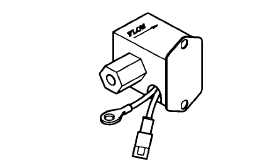| |
TM 10-3930-671-24
WARNING
Smoking or open flame should be
avoided any time the fuel system is
being serviced or repaired. The work
area should be properly ventilated.
Clean up all fuel spills. Improper
handling of fuel could result in an
explosion or fire causing bodily Injury
to yourself or others.
Fuel Supply (Transfer) Pump
The electric fuel supply pump is a solenoid-operated,
plunger-type pump mounted on the engine cylinder block
fuel pump pad and operated from the truck battery
electrical system. It is completely sealed against fuel
leakage and has the ability to prime itself and the filter
without engine cranking.
The fuel pump is energized in the ignition circuit which
ensures prompt filling of the fuel filter and fuel line to
effect easy starting.
Fuel Pump Troubleshooting
When fuel pump trouble is suspected, disconnect the
fuel line at the input side of the fuel injection pump. Turn
ignition switch ON. Pump fuel into a small container,
then place your finger on the outlet side of the fuel line.
If the pump stops or ticks very infrequently, the pump
and fuel line connections are satisfactory. Remove your
finger from the fuel line, and if ample fuel flows, the
pump is satisfactory.
If the pump ticks (pumps) with your finger on the fuel
line, it may mean that there is a leak in the fuel supply
line. Check for loose fittings or damaged fuel lines.
Repair or replace, as necessary.
If the fuel does not flow and/or the pressure is below
1.50-2.25 psi [77-116 mm Hg] range, the pump should
be replaced.
WARNING
Before disconnecting lines, be sure to relieve all
pressure. Before applying pressure to the
system, be sure all connections are tight and
that lines, pipes and hoses are not damaged.
Use a piece of cardboard, rather than hands, to
search for leaks. Escaping fluid under pressure
can have sufficient force to penetrate the skin,
causing personal Injury. If Injured by escaping
fluid, get medical attention at once.
Priming the Fuel System
Priming is necessary on initial installation of the fuel
injection system, after any subsequent removal, and if
the system should be drained by running out of fuel.
Before priming and venting the fuel system, be sure that
the outside of the vent screws and surrounding area is
thoroughly clean to prevent dirt and foreign matter from
entering the system.
NOTE
Electrical equipment such as starters
should be shielded to prevent fuel
damage during priming.
1.
Loosen the filter outlet (A), or the fuel injection
pump inlet connection (B) whichever is at the
highest point, and allow fuel to flow until free of
air. Tighten connections.
NOTE
Filters of the four-boas type must
also be vented at the plugged boss;
this must be done regardless of the
height of the filter in the system.
2.
Loosen the vent valve fitted on one of the two
hydraulic head locking screws (C), and the vent
screw (D) on the governor housing. When fuel
free of air flows from the vents, tighten the
housing vent screw and then the governor vent
screw.
F-203
|



